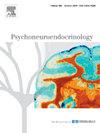Hatha yoga reduces momentary stress but does not impact diurnal profiles of salivary cortisol and alpha-amylase: A randomized controlled trial
IF 3.4
2区 医学
Q2 ENDOCRINOLOGY & METABOLISM
引用次数: 0
Abstract
Does the practice of yoga impact stress? Various studies have suggested that yoga may reduce both self-reported stress and stress biomarkers, but the evidence for such claims remains inconclusive, especially for yoga styles with a focus on physical postures. In a randomized controlled trial with 98 participants, we therefore examined whether an eight-week Hatha yoga intervention (60 min, 3×/week or more) led to reduced levels of diurnal salivary cortisol (sCort), salivary alpha-amylase (sAA), and subjective momentary stress as compared to a waitlist control group. To ensure the concomitant assessment of self-report and biological measures in an ecologically valid setting, and to capture the diurnal profile of cortisol and alpha-amylase, we employed an ecological momentary assessment approach. Five times per day, participants reported their momentary stress levels on a visual analogue scale and collected saliva samples for the assessment of salivary biomarkers. The intervention led to a significant reduction of subjective momentary stress but there was no change in diurnal sCort or sAA levels. There are several potential explanations for these findings: The intervention may have helped participants to cope better with stress while leaving diurnal levels of stress biomarkers unaffected, or the change may at least not have been reflected in sCort and sAA. Alternatively, there may have been a self-report bias, insofar as a favorable disposition towards yoga may have led participants to report reductions in stress in order to indicate positive effects of the intervention. Our findings contribute to a better understanding of the effects of distinct yoga interventions, demonstrating their potential to serve as low-risk stress relief tools.
哈达瑜伽能减轻瞬间压力,但不会影响唾液皮质醇和α-淀粉酶的昼夜变化:随机对照试验
练习瑜伽会影响压力吗?多项研究表明,瑜伽可以减少自我报告的压力和压力生物标志物,但这种说法的证据仍不确定,尤其是以身体姿势为主的瑜伽方式。因此,在一项有 98 名参与者参加的随机对照试验中,我们研究了为期八周的哈达瑜伽干预(60 分钟,每周 3 次或更多次)是否会导致昼间唾液皮质醇(sCort)、唾液α-淀粉酶(sAA)和主观瞬间压力水平的降低,并与等待对照组进行了比较。为了确保在生态有效的环境中同时评估自我报告和生物测量,并捕捉皮质醇和α-淀粉酶的昼夜变化,我们采用了生态瞬间评估方法。参与者每天五次用视觉模拟量表报告自己的瞬间压力水平,并收集唾液样本以评估唾液生物标志物。干预措施显著降低了主观瞬间压力,但昼夜皮质醇(sCort)或钙化血红蛋白(sAA)水平没有变化。这些结果有几种可能的解释:干预可能帮助参与者更好地应对压力,而使压力生物标志物的昼夜水平不受影响,或者这种变化至少没有反映在 sCort 和 sAA 上。另外,也可能存在自我报告偏差,因为对瑜伽的好感可能会使参与者报告压力减少,以显示干预的积极效果。我们的研究结果有助于更好地了解不同瑜伽干预措施的效果,证明它们有潜力成为低风险的压力缓解工具。
本文章由计算机程序翻译,如有差异,请以英文原文为准。
求助全文
约1分钟内获得全文
求助全文
来源期刊

Psychoneuroendocrinology
医学-精神病学
CiteScore
7.40
自引率
8.10%
发文量
268
审稿时长
66 days
期刊介绍:
Psychoneuroendocrinology publishes papers dealing with the interrelated disciplines of psychology, neurobiology, endocrinology, immunology, neurology, and psychiatry, with an emphasis on multidisciplinary studies aiming at integrating these disciplines in terms of either basic research or clinical implications. One of the main goals is to understand how a variety of psychobiological factors interact in the expression of the stress response as it relates to the development and/or maintenance of neuropsychiatric illnesses.
 求助内容:
求助内容: 应助结果提醒方式:
应助结果提醒方式:


